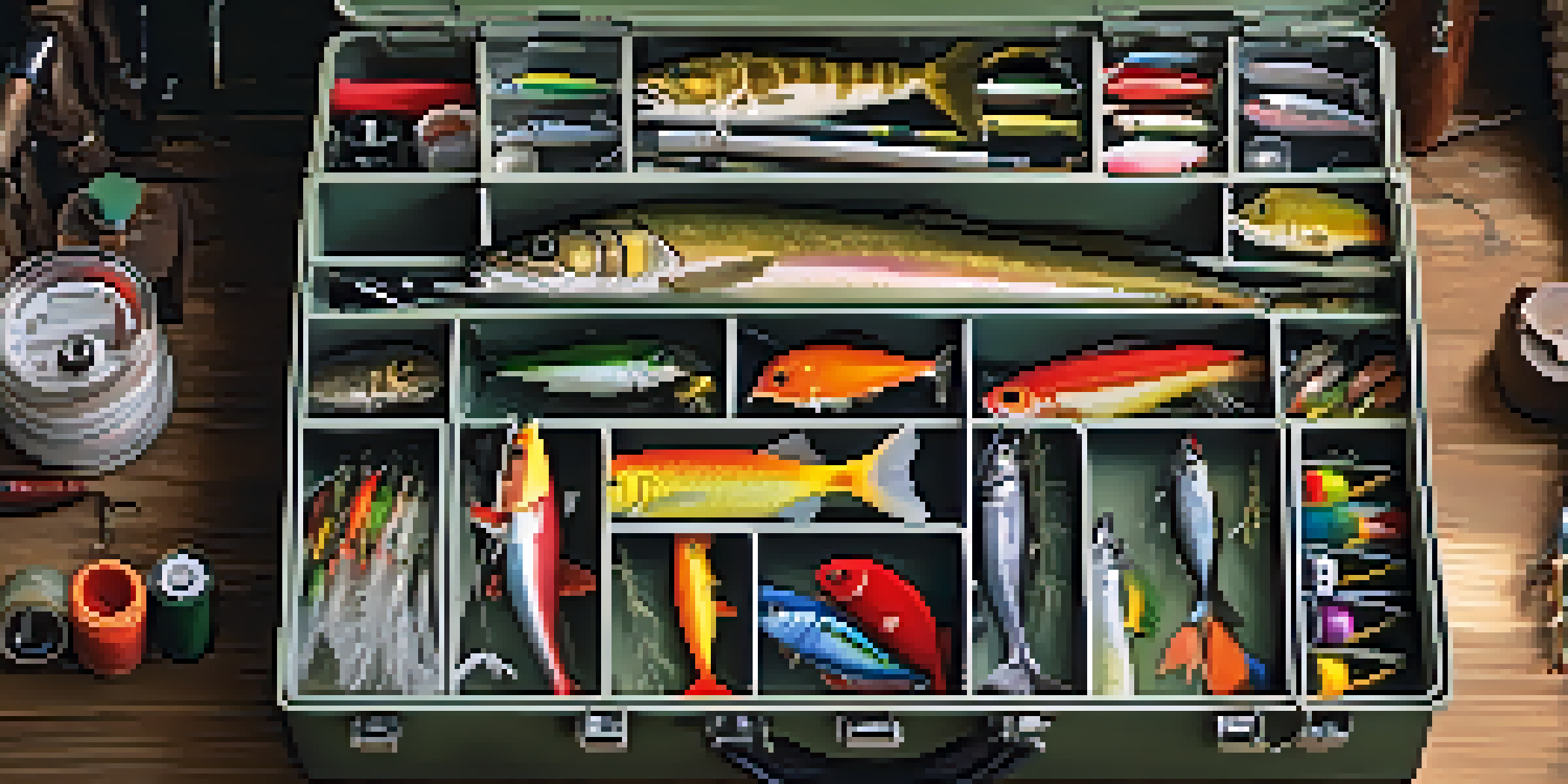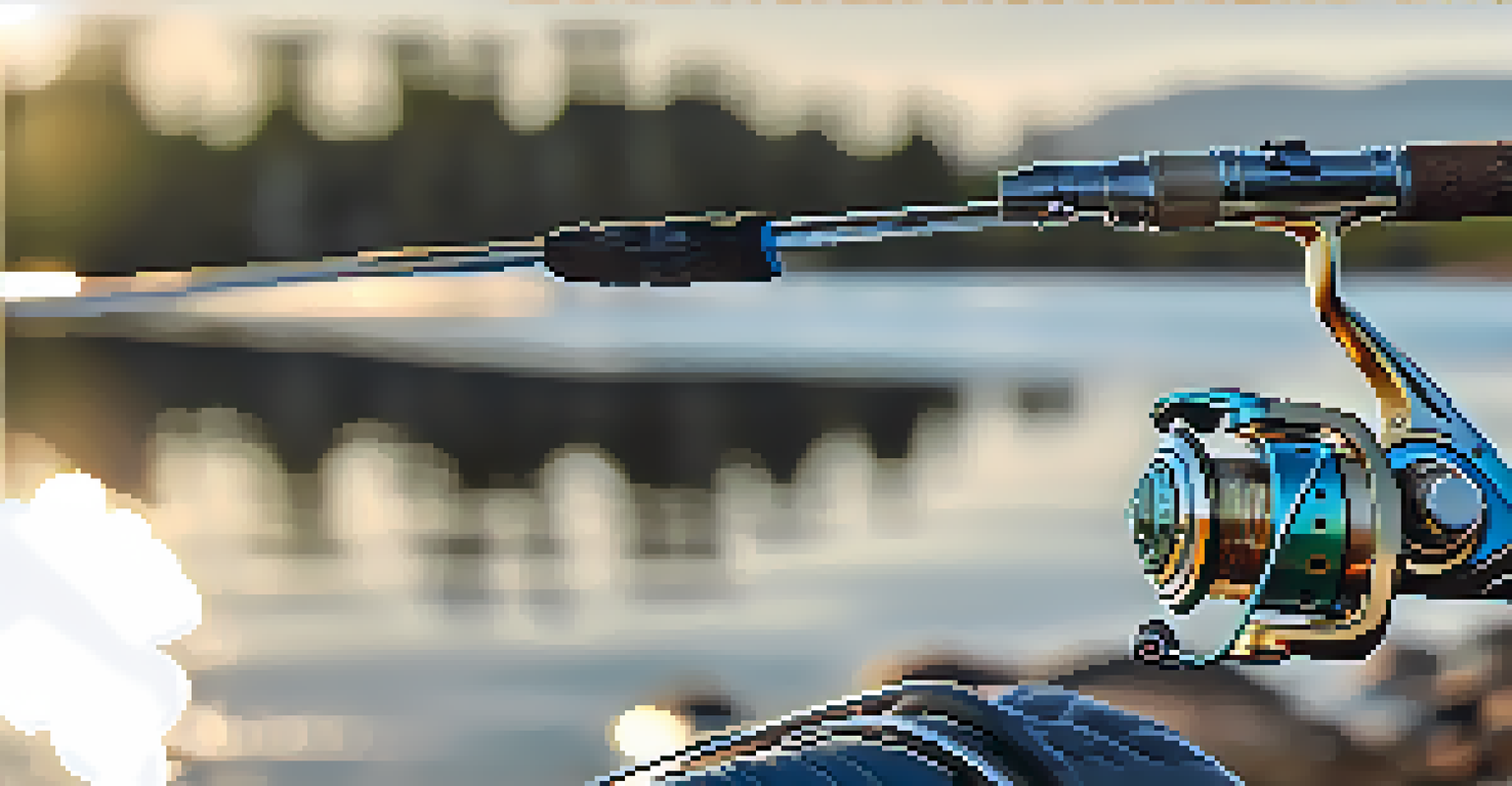Fishing Tackle: A Comprehensive Guide for Beginners

Understanding Fishing Tackle: What You Need to Know
Fishing tackle refers to the equipment used by anglers to catch fish. This includes rods, reels, lines, hooks, and bait. Understanding the basics of fishing tackle is crucial for beginners to ensure a successful fishing experience.
Fishing is not an escape from life, but often a deeper immersion into it.
Choosing the right tackle can seem overwhelming at first, but it doesn't have to be. Think of it as selecting ingredients for a recipe; each component plays a vital role in the outcome. By familiarizing yourself with the different types, you can make informed choices.
Ultimately, your tackle should suit your fishing style and target species. Whether you're angling in freshwater or saltwater, knowing the essentials will boost your confidence and increase your chances of landing that big catch.
Essential Fishing Rods: Types and Features Explained
The fishing rod is your primary tool for casting and retrieving. There are several types, including spinning rods, baitcasting rods, and fly rods, each designed for specific fishing techniques. Understanding these differences will help you select the right rod for your needs.

For beginners, spinning rods are often the most user-friendly. They allow for easy casting and are versatile for various fishing situations. Imagine them as the Swiss Army knife of fishing rods; they can handle a bit of everything.
Understanding Fishing Tackle Basics
Familiarizing yourself with fishing tackle components like rods, reels, and lines is essential for a successful fishing experience.
When choosing a rod, consider factors like length, power, and action. A longer rod casts farther, while a shorter rod offers better control. By understanding these features, you can find a rod that feels right in your hands and fits your fishing style.
Reels 101: Selecting the Right Fishing Reel for You
A fishing reel is an essential component that helps you control the line and catch fish. The two main types are spinning reels and baitcasting reels. Each has its advantages, and your choice should depend on your fishing technique and experience level.
The charm of fishing is that it is the pursuit of what is elusive but attainable, a perpetual series of occasions for hope.
Spinning reels are great for beginners due to their ease of use and versatility. They work well with various lures and baits, making them a popular choice for those just starting. Think of it as using a simple point-and-click camera; it's straightforward and effective.
On the other hand, baitcasting reels offer more precision and control, but they require a bit more practice. If you're ready to take the plunge into baitcasting, start with lighter baits and practice your casting technique to avoid frustrating backlashes.
Fishing Lines: Types and How to Choose the Best One
Fishing lines play a crucial role in connecting your tackle to the fish. There are three main types: monofilament, fluorocarbon, and braided line. Each type has its strengths and weaknesses, so understanding them will help you make the right choice.
Monofilament lines are popular among beginners due to their affordability and ease of use. They are stretchy, which can help absorb sudden shocks from a fish. It's like using elastic bands—they're reliable and flexible for various situations.
Choosing the Right Fishing Rod
Selecting the appropriate fishing rod based on type, length, and action can enhance your casting effectiveness and overall enjoyment.
Fluorocarbon lines are nearly invisible underwater and are great for clear water fishing. Braided lines, on the other hand, offer incredible strength for their diameter. By choosing the right line, you can enhance your fishing experience and increase your chances of success.
Hooks and Baits: The Heart of Your Fishing Setup
Hooks and baits are crucial for attracting fish. There are various types of hooks, including circle hooks, treble hooks, and bait hooks, each suited for different fishing scenarios. Understanding these options will help you set up your tackle effectively.
When it comes to bait, you can choose between live bait, artificial lures, or a combination of both. Live bait like worms or minnows can be highly effective, while artificial lures offer a variety of colors and movements to entice fish. Think of it as choosing between homemade and store-bought; both can work well in the right situation.
Experimenting with different hook sizes and bait types can lead to exciting fishing adventures. Remember, matching your bait to the fish species you're targeting can significantly improve your success rate.
Tackle Boxes: Organizing Your Fishing Gear Like a Pro
A tackle box is essential for keeping your fishing gear organized and easily accessible. With various sizes and styles available, you can find one that fits your needs and preferences. Think of it as your fishing toolbox, where everything has its place.
When organizing your tackle box, consider separating items by category, like hooks, lures, and weights. This way, you won’t waste time searching for what you need when you're out on the water. A little organization goes a long way in maximizing your fishing experience.
Maintaining Fishing Gear Properly
Regular maintenance of your fishing tackle, including cleaning and inspecting equipment, ensures longevity and optimal performance.
Additionally, label compartments or use small containers to keep everything neat. An organized tackle box not only improves efficiency but also makes your fishing trips more enjoyable.
Tips for Maintaining Your Fishing Tackle: Best Practices
Proper maintenance of your fishing tackle ensures its longevity and optimal performance. After each fishing trip, it's essential to clean your gear, especially your reels and rods. Think of it as giving your equipment a little TLC; it'll pay off in the long run.
Inspect your line for any frays or damages and replace it as needed. Regularly check the condition of your hooks, and sharpen or replace them to ensure they're always ready for action. A well-maintained tackle can make all the difference on a fishing day.

Finally, store your tackle in a cool, dry place to prevent corrosion and damage. By adopting these best practices, you'll be well on your way to becoming a responsible and successful angler.